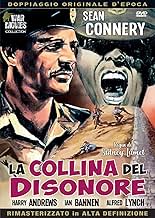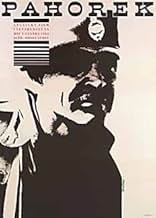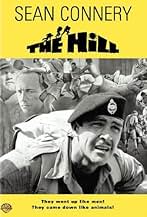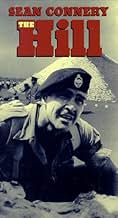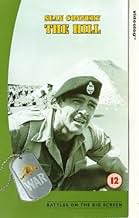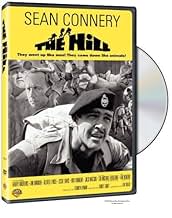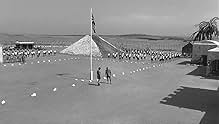CALIFICACIÓN DE IMDb
7.8/10
16 k
TU CALIFICACIÓN
Durante la Segunda Guerra Mundial, un grupo de prisioneros ingleses se encuentra encarcelado en un campo militar del norte de África. Allí sufren la ira de un sádico sargento.Durante la Segunda Guerra Mundial, un grupo de prisioneros ingleses se encuentra encarcelado en un campo militar del norte de África. Allí sufren la ira de un sádico sargento.Durante la Segunda Guerra Mundial, un grupo de prisioneros ingleses se encuentra encarcelado en un campo militar del norte de África. Allí sufren la ira de un sádico sargento.
- Ganó 1 premio BAFTA
- 4 premios ganados y 6 nominaciones en total
Michael Redgrave
- The Medical Officer
- (as Sir Michael Redgrave)
Michael Hawkins
- Prisoner
- (sin créditos)
James Payne
- Man in Prison
- (sin créditos)
Robert Royal
- Prisoner
- (sin créditos)
Harold Sanderson
- Officer
- (sin créditos)
Opiniones destacadas
One of Sean Connery's personal favorites among his movies is The Hill. He had high hopes for its success and that it would break him out of the James Bond mold. Unfortunately the movie going public wanted more James Bond and less Sean Connery at this point.
The Hill is close to a perfect masterpiece of characterization and cinematography. Director Sidney Lumet opted for black and white in making The Hill and I think it enhances the stark surroundings of the British military stockade in North Africa. These are really the forgotten people of World War II.
If Sean Connery could have gotten a chance for a Dirty Dozen type mission from the British army he would have taken it. His character is very similar to Charles Bronson's from that film. Bronson was an officer, Connery a sergeant major, Bronson shot, Connery struck a superior with extremely good cause, but their respective armies didn't see it that way.
So now Sean is in a cell with four other prisoners all of varying character, Roy Kinnear, Ossie Davis, Jack Watson, and Alfred Lynch. Norman Bird is the commandant, but the camp is really run as in all armies by the Sergeant-Major Harry Andrews. Andrews has a special punishment for the prisoners, called The Hill; a specially constructed mound of sand about 200 feet high where they have to run up and down it with field pack in the desert heat.
Andrews has the assistance of Staff Sergeant Ian Hendry who has his own sadistic bent quite apart from military punishment. When one of Connery's cell-mates dies from punishment, all hell threatens to break loose.
One of the things that attracted Sean Connery to this film according to the Citadel Film series book on his work was the fact that it was unlike James Bond, no glamorous locations, no fancy wardrobe and absolutely no romance. This would give him the chance to show he could be something other than James Bond.
Connery got rave reviews for playing former Sergeant Major Joe Roberts in The Hill and the rest of the cast Sidney Lumet assembled did likewise. Unfortunately the film failed at the box office. Connery remarked that without his name on it, this would have been an art house special limited release type of work. But the public only wanted to see James Bond and it wasn't until The Anderson Tapes that Sean Connery finally got great reviews in a film that did well at the box office as well as the critics.
Over 40 years after it was released The Hill now is considered a cinema masterpiece. Besides Connery my favorite performances are from Michael Redgrave as the medical officer who's not a strong man, but steps to the plate when his duty is clear and from Ossie Davis as a cynical black soldier who finally grows tired of the institutional racism he finds and 'leaves' the army. You won't forget them, Connery or The Hill once you see it.
The Hill is close to a perfect masterpiece of characterization and cinematography. Director Sidney Lumet opted for black and white in making The Hill and I think it enhances the stark surroundings of the British military stockade in North Africa. These are really the forgotten people of World War II.
If Sean Connery could have gotten a chance for a Dirty Dozen type mission from the British army he would have taken it. His character is very similar to Charles Bronson's from that film. Bronson was an officer, Connery a sergeant major, Bronson shot, Connery struck a superior with extremely good cause, but their respective armies didn't see it that way.
So now Sean is in a cell with four other prisoners all of varying character, Roy Kinnear, Ossie Davis, Jack Watson, and Alfred Lynch. Norman Bird is the commandant, but the camp is really run as in all armies by the Sergeant-Major Harry Andrews. Andrews has a special punishment for the prisoners, called The Hill; a specially constructed mound of sand about 200 feet high where they have to run up and down it with field pack in the desert heat.
Andrews has the assistance of Staff Sergeant Ian Hendry who has his own sadistic bent quite apart from military punishment. When one of Connery's cell-mates dies from punishment, all hell threatens to break loose.
One of the things that attracted Sean Connery to this film according to the Citadel Film series book on his work was the fact that it was unlike James Bond, no glamorous locations, no fancy wardrobe and absolutely no romance. This would give him the chance to show he could be something other than James Bond.
Connery got rave reviews for playing former Sergeant Major Joe Roberts in The Hill and the rest of the cast Sidney Lumet assembled did likewise. Unfortunately the film failed at the box office. Connery remarked that without his name on it, this would have been an art house special limited release type of work. But the public only wanted to see James Bond and it wasn't until The Anderson Tapes that Sean Connery finally got great reviews in a film that did well at the box office as well as the critics.
Over 40 years after it was released The Hill now is considered a cinema masterpiece. Besides Connery my favorite performances are from Michael Redgrave as the medical officer who's not a strong man, but steps to the plate when his duty is clear and from Ossie Davis as a cynical black soldier who finally grows tired of the institutional racism he finds and 'leaves' the army. You won't forget them, Connery or The Hill once you see it.
The Hill is a brutal film to watch. It stars a (relatively) young Sean Connery as he attempts to avoid being typecast as James Bond and features recognizable British actors in support. It's a psychological thriller set in a prison camp for court-martialed British soldiers, a rugged, terrifying camp run by a ruthless sergeant-major, played by Harry Andrews.
Connery is Joe Roberts, in the klink for slugging a superior officer after refusing to (re)enter the field of battle (his squad was hopelessly outnumbered and outflanked; see also Paths of Glory). Roberts is tossed in a cell with fellow cons George Stevens (Alfred Lynch), Jacko King (Ossie Davis), Monty Bartlett (Roy Kinnear), and Jock McGrath (Jack Watson), who alternately resent and respect Roberts' actions.
The hill of the title is a steep, sandy incline in the middle of the Sahara, where the camp's located. Convicts are tasked with double-timing it up one side and down the other, carrying a loaded backpack and their kit, or duffel bag. And then back again. The hill is used as a way for RSM Wilson (Andrews) to break them, to make them into real soldiers again.
Trouble arises when Wilson's second in command, Staff Sergeant Williams (Ian Hendry) badgers one of the convicts so relentlessly that the man dies, thus kicking the battle of wits between prisoner and gatekeeper to an entirely new level. And this is where we really begin to see the unvarnished war of man versus man, as Wilson and Williams strain to break not only Roberts but also his cellmates.
Connery is really fantastic as the strong-willed Roberts, and Wilson – who played plenty of authoritarian, stiff-backed British characters, is his equal. It's good to see Connery in a movie that transcends his sex appeal and his association with a certain superspy. Filmed in stark black and white (as black and white tends to be), The Hill is near the apex of psychological war films.
Connery is Joe Roberts, in the klink for slugging a superior officer after refusing to (re)enter the field of battle (his squad was hopelessly outnumbered and outflanked; see also Paths of Glory). Roberts is tossed in a cell with fellow cons George Stevens (Alfred Lynch), Jacko King (Ossie Davis), Monty Bartlett (Roy Kinnear), and Jock McGrath (Jack Watson), who alternately resent and respect Roberts' actions.
The hill of the title is a steep, sandy incline in the middle of the Sahara, where the camp's located. Convicts are tasked with double-timing it up one side and down the other, carrying a loaded backpack and their kit, or duffel bag. And then back again. The hill is used as a way for RSM Wilson (Andrews) to break them, to make them into real soldiers again.
Trouble arises when Wilson's second in command, Staff Sergeant Williams (Ian Hendry) badgers one of the convicts so relentlessly that the man dies, thus kicking the battle of wits between prisoner and gatekeeper to an entirely new level. And this is where we really begin to see the unvarnished war of man versus man, as Wilson and Williams strain to break not only Roberts but also his cellmates.
Connery is really fantastic as the strong-willed Roberts, and Wilson – who played plenty of authoritarian, stiff-backed British characters, is his equal. It's good to see Connery in a movie that transcends his sex appeal and his association with a certain superspy. Filmed in stark black and white (as black and white tends to be), The Hill is near the apex of psychological war films.
Hot and sweaty, bold and brutal, Sidney Lumet's The Hill is a tour de force of incarceration based cinema. Story has five new inmates sent to a North African based British Army Prison, the centre piece of which is a manufactured hill that is used as a punishment tool. The new recruits, headed by Joe Roberts (Sean Connery), quickly fall foul of the superiors, especially the venomous Staff Sergeant Williams (Ian Hendry), but these boys wont take it lying down...
With no music and Oswald Morris' monochrome photography ensuring atmosphere is perpetually claustrophobic, the harsh edges of the story strike hard. Be it overt bullying by those in charge - pushing men evidently too far - or racism, Lumet melds everything together superbly for harsh viewing experience, tightening the screws every quarter of film. Come the shattering conclusion it's a merciful release for the viewers, a chance to start breathing properly again, even if your mind is ablaze with a number of thoughts.
This is very much an actors picture, which seems a given since it's adapted by Ray Rigby from his own play, but a mightily strong cast do sterling work with the tinderbox screenplay. Ossie Davis, Harry Andrews, Ian Bannen, Roy Kinnear, Alfred Lynch and Michael Redgrave fill out the other key roles, each giving their characters vivid depth without resorting to histrionics and scenery chewing. Which of course is a testament to Lumet's skills as a director of actors.
Slow burning intensity bristles with the corrosive nature of machismo fuelled authority, an unforgettable film and highly recommended to those who have not sampled it yet. 9/10
With no music and Oswald Morris' monochrome photography ensuring atmosphere is perpetually claustrophobic, the harsh edges of the story strike hard. Be it overt bullying by those in charge - pushing men evidently too far - or racism, Lumet melds everything together superbly for harsh viewing experience, tightening the screws every quarter of film. Come the shattering conclusion it's a merciful release for the viewers, a chance to start breathing properly again, even if your mind is ablaze with a number of thoughts.
This is very much an actors picture, which seems a given since it's adapted by Ray Rigby from his own play, but a mightily strong cast do sterling work with the tinderbox screenplay. Ossie Davis, Harry Andrews, Ian Bannen, Roy Kinnear, Alfred Lynch and Michael Redgrave fill out the other key roles, each giving their characters vivid depth without resorting to histrionics and scenery chewing. Which of course is a testament to Lumet's skills as a director of actors.
Slow burning intensity bristles with the corrosive nature of machismo fuelled authority, an unforgettable film and highly recommended to those who have not sampled it yet. 9/10
Sidney Lumet's The Hill is a stark, uncompromising look at the inside of a British military prison in North Africa during WW II. The all-male film, based on Ray Rigby's autobiographical play, is about the brutal mistreatment of prisoners by the screws at a stockade for court-martialed British soldiers.
The titular 'hill' is a monstrous man-made pile of sand seared by the blazing sun, to be used as a means of punishment in the blistering heat. A sadistic martinet Major Bert Wilson (Harry Andrews) runs the show here with an aim to break the soldier-prisoners down and then build them up to return as soldiers. His fascist method of discipline is to have the inmates clambering with full kit in the heat up and down the dreaded hill even if they are exhausted, as part of a punishment designed more to break a man's spirit rather than provide corrective treatment. The screenplay puts the spotlight on a new bunch of five new prisoners, one of whom is the hard-mouthed tank-man Roberts (Sean Connery). Together, they form an eclectic mix but all have one thing in common: they are terrorized by Sergeant Williams (Ian Hendry), a particularly sadistic new guard chosen by Major Wilson, who relishes the task of marching the men up and down the hill and watching them suffer. When Williams goes too far and causes the death of on the five men due to heat stroke, it sparks off a mutiny and Roberts decides to lodge a charge of murder against Williams. The stage is thus set for a dramatic and riveting confrontation, thrusting the drama to its bruising, ironic end.
In this long and unrelenting documentation of life in a military stockade, Sidney Lumet comes up with the sobering revelation that inhumanity is not unique with the enemy, in his own inimitable style. The cinematography is superlative as Oswald Morris shoots the film in monochromatic hues, making you feel parched from minute one. The acting is also top-notch. Harry Andrews is devastating as the sergeant major that runs the camp - a taut, controlled administrator who is a professional military man and Ian Hendry is brilliantly sinister as the evil sergeant who precipitates the crisis. Connery tears up the screen as the rebellious inmate, giving an intelligently restrained performance, carefully avoiding forced histrionics. Ossie Davis gets some of the best scenes and plays them superbly.
'The Hill' is a harsh, sadistic and brutal entertainment, made without any concessions to officialdom - among the best of the sub-genre has to offer.
The titular 'hill' is a monstrous man-made pile of sand seared by the blazing sun, to be used as a means of punishment in the blistering heat. A sadistic martinet Major Bert Wilson (Harry Andrews) runs the show here with an aim to break the soldier-prisoners down and then build them up to return as soldiers. His fascist method of discipline is to have the inmates clambering with full kit in the heat up and down the dreaded hill even if they are exhausted, as part of a punishment designed more to break a man's spirit rather than provide corrective treatment. The screenplay puts the spotlight on a new bunch of five new prisoners, one of whom is the hard-mouthed tank-man Roberts (Sean Connery). Together, they form an eclectic mix but all have one thing in common: they are terrorized by Sergeant Williams (Ian Hendry), a particularly sadistic new guard chosen by Major Wilson, who relishes the task of marching the men up and down the hill and watching them suffer. When Williams goes too far and causes the death of on the five men due to heat stroke, it sparks off a mutiny and Roberts decides to lodge a charge of murder against Williams. The stage is thus set for a dramatic and riveting confrontation, thrusting the drama to its bruising, ironic end.
In this long and unrelenting documentation of life in a military stockade, Sidney Lumet comes up with the sobering revelation that inhumanity is not unique with the enemy, in his own inimitable style. The cinematography is superlative as Oswald Morris shoots the film in monochromatic hues, making you feel parched from minute one. The acting is also top-notch. Harry Andrews is devastating as the sergeant major that runs the camp - a taut, controlled administrator who is a professional military man and Ian Hendry is brilliantly sinister as the evil sergeant who precipitates the crisis. Connery tears up the screen as the rebellious inmate, giving an intelligently restrained performance, carefully avoiding forced histrionics. Ossie Davis gets some of the best scenes and plays them superbly.
'The Hill' is a harsh, sadistic and brutal entertainment, made without any concessions to officialdom - among the best of the sub-genre has to offer.
Stark images, powerful script and performances, and rapid, sharp editing make this film difficult to forget. Director Sidney Lumet stamps his authority on the movie with a style that is gritty, almost documentary -like. The quick cuts are precise, like the snap of the salutes and the bark of the NCO's. Beyond Lumet's towering presence, there is a likeable performance from a young Ossie Davis, an excellent early non-Bond performance from Sean Connery, and Harry Andrews' Sargeant-Major is a remarkable creation - a little man whose job is to destroy these misfits on behalf of a system that will not tolerate individuals.
This remarkable film stays in the mind long after viewing for me, mainly because it announces early on that it is not an easy picture, and like early Frankenheimer, it's aggressive style stands out from the norm. It is a quintessential sixties picture - a time when experiments in style could be taken seriously - not just a smirky in-jokes or cartoonish roller -coaster rides. Exhilarating nonetheless.
This remarkable film stays in the mind long after viewing for me, mainly because it announces early on that it is not an easy picture, and like early Frankenheimer, it's aggressive style stands out from the norm. It is a quintessential sixties picture - a time when experiments in style could be taken seriously - not just a smirky in-jokes or cartoonish roller -coaster rides. Exhilarating nonetheless.
¿Sabías que…?
- TriviaFilming took place in Almería, Spain in a sandy wasteland called Cabo de Gata starting in September 1964 for five weeks on location. An old Spanish fort in Málaga was used for the prison.
Many people associated with the production had regarded the filming as pleasant, despite difficult conditions---The temperatures rarely fell below 115 degrees Fahrenheit (46 degrees Celsius), and despite the 2,000 gallons of pure water that were shipped in for the crew, almost everyone succumbed to dysentery during the shoot.
- ErroresThe first time the new arrivals are shown around "the hill" by Staff Williams, the shadow of the rig is clearly visible as the camera performs a 360 degree shot from the top of the hill.
- Citas
Trooper Joe Roberts: We're all doing time. Even the screws.
- Versiones alternativasColorized version was broadcast over TNT Network June 7, 1989.
- ConexionesFeatured in The Sun... the Sand... the Hill. (1965)
Selecciones populares
Inicia sesión para calificar y agrega a la lista de videos para obtener recomendaciones personalizadas
- How long is The Hill?Con tecnología de Alexa
Detalles
Taquilla
- Presupuesto
- USD 2,500,000 (estimado)
- Tiempo de ejecución
- 2h 3min(123 min)
- Color
- Relación de aspecto
- 1.85 : 1
Contribuir a esta página
Sugiere una edición o agrega el contenido que falta


